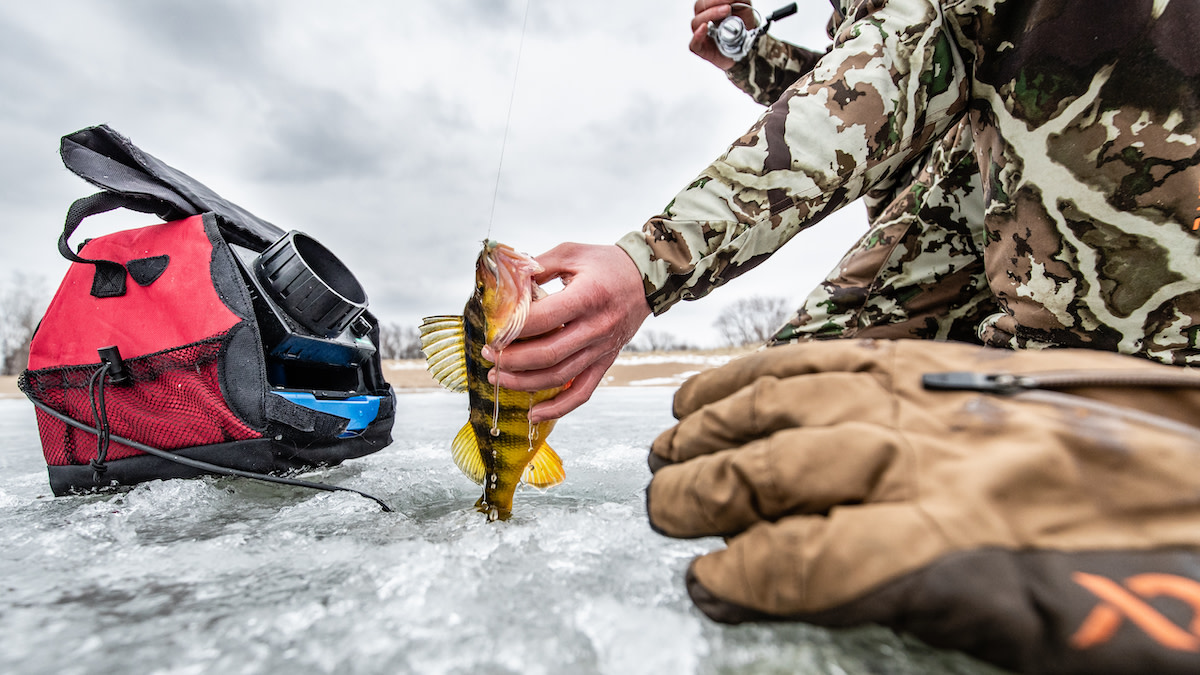
Perch seem to take a back seat to species like bluegills, crappies, and walleyes when ice fishing. Honestly, it isn’t fair or warranted. They generally travel in large schools, make amazing table fare, and can be found from the Great Lakes to your local farm pond. Once you locate hardwater perch, a few different presentations are all that’s needed. These three rigs will help you get more perch topside, regardless of where you ice fish.
Jiggle Them
Jigging is nothing new to ice fishing, but technology has drastically changed how we jig for perch. Many small jigs used for bluegills and crappies don’t have weight or hook size that’s ideal for perch. Tungsten jigs are denser than lead, so they come in a more compact package that allow jigs to get deeper, quicker.
New-age jigs feature hooks that are three or four times the size of older models, making them less likely to bend and break. Clam Pro Tackle helped start this trend with their XL series of jigs several years ago. The demand has increased enough that more models feature XL and XXL hooks. A larger hook is beneficial for big perch or anytime you’re using soft plastics. Be aware that many of these plastics threaded onto the jig of a normal-size hook will leave little room to set the hook.
The type of rod and reel used for small jigs can significantly alter your presentation. In-line, fly-style reels like the Black Betty from 13 Fishing are popular with panfishermen because they reduce line and lure twist. Less twist makes the lure look natural in the water and the line more manageable on the reel. Pair this with a rod that has a lot of backbone and light tip, like the 13 Omen Ice. The touchy first few inches of the tip allows anglers to see bites before they feel them, while the rest of the rod provides enough backbone for a solid hookset.
Body Baits
Small lipless crankbaits originally designed for open water have been taking off in popularity for hardwater applications. Popular models include the Rapala UL Rippin’ Rap, and Eurotackle Z Viber. Depending on the size and weight you need for local waters, the options are almost endless. In extremely clear water or where fish are pressured, look for models without rattles, such as the Salmo Chubby Darter or Rapala Slab Rap.
When fishing body baits, some slight modifications to your rigging will increase success. A small spinning reel with your choice of line works great, but make sure to tie a short leader of approximately 18 inches attached with a very small swivel. The small swivel is crucial in order to not have too strong of a return on your electronics. Finish the leader with a micro snap at the lure end. This setup will make changing lures easier and drastically reduce line twist.
A fast-action rod will fish these body baits better than the extra-fast actions often found on jig rods. The more parabolic or gradual bend keeps you from over-fishing the bait and does wonders for keeping fish buttoned up.
Get the Drop
One of the trickiest tricks in perch fishing is to stay on top of the ever-moving schools. Catching one perch seems to intrigue or at least keep the rest from moving on. One of the best ways to accomplish this is with a dropper jig. Essentially, a dropper jig is just a small spoon with the hook removed and replaced with a bead chain hook.
The Clam Speed Spoon was named appropriately. The object is to get the presentation back down the hole as quickly as possible, with an element of finesse. When fish hit the lure the chain goes slack and the fish doesn’t feel the resistance of the heavy spoon body. Chains are available with both single and treble hooks. Singles are popular with anglers using perch eyes or larger live baits. Treble hooks generally take more time to unhook and reset, so they are preferred by anglers that want to tip with several spikes or wax worms. In recent years, chain droppers have gained enough popularity that aftermarket “jeweled” or glow hooks are available to fancy up the package.
As popular as the Speed Spoon is, there are times where you just need more beef. Fishing in current or depths past 30 feet often means bulking up. When this is the case, take smaller-sized walleye spoons such as the Silver Streak Rattle Streak or Northland Buckshot and make your own dropper jig. Simply remove the treble hook and add a chain. Another option is to use either a homemade or store-bought stinger hook.
Using a larger presentation gives fish the opportunity to knock slack in the lure without you feeling it. This means the rod and reel setup matters as much or more than any other presentation. An extra-fast action 13 Archangel rod paired with a small diameter braided line such as the Clam Frost line helps give you more feel on light bites and better hookups in deeper water.
Perch can be frustrating when they go from hitting anything that moves to lockjaw within minutes. Having these three tactics in your arsenal will improve your perch harvest even in the toughest waters.
Feature image via Captured Creative.





